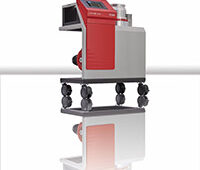A pipette is a common laboratory tool used to transport and deliver small measured volumes of liquid. Pipettes now encompass a diverse range of instruments, with widely varying accuracy. The earliest pipettes were simple glass tubes with a narrowing tip at the bottom, and a separate a flexible bulb covering the top. Many more modern forms of pipettes are now used, both manual and automated.
The original pipette, with a narrowing glass tube and flexible bulb, is known as a Pasteur pipette or dropper. The bulb is compressed between finger and thumb, expelling air. The tip is then placed in a liquid and the bulb is released, causing liquid to be drawn into the tube as the bulb expands. Gently squeezing the bulb allows the liquid to be expelled one drop at a time.
Volumetric pipettes are simple manual devices that achieve very high accuracy, but each device is only calibrated to deliver one specific volume. They consist of a glass bulb linked to two glass tubes extending in opposite directions. These pipettes are calibrated as either TD (calibrated to deliver the specified volume) or TC (calibrated to contain the specified volume with no remainder). A pipette bulb is temporarily attached to a volumetric pipette in order to draw up the liquid. The bulb is then removed and a finger is placed over the upper tube to create an air lock. Waste liquid is drained by releasing the finger, until the liquid reaches the upper graduation. The pipette can then be moved to the dispensing location and the finger again released, this time until the liquid drains to the lower graduation.
Graduated pipettes work in essentially the same way as a volumetric pipette. However, rather than containing a bulb with an upper and lower graduation on a very narrow-bore tube, graduated pipettes have a straight tube with many graduations, allowing a range of volumes to be dispensed, but with lower accuracy.
Pipettes are closely related to burettes which serve the same purpose of dispensing small volumes of liquid with high accuracy. Burettes differ in their use of a valve to control the flow of the liquid.
The operation of pipettes can be partially or fully automated through the use of electronic pipettes, which automatically deliver a preset volume, robotic operation, and multichannel pipettes. Multichannel pipettes are effectively a number of separate pipettes mounted in a row so that then can all be dispensed simultaneously, generally each into a separate sample tube, with the tubes also arranged in a row in a test rack.





Tell Us What You Think!